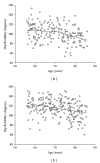Flexibility of older adults aged 55-86 years and the influence of physical activity
- PMID: 23862064
- PMCID: PMC3703899
- DOI: 10.1155/2013/743843
Flexibility of older adults aged 55-86 years and the influence of physical activity
Abstract
Cross-sectional age-related differences in flexibility of older adults aged 55-86 years of varying activity levels were examined. Shoulder abduction and hip flexion flexibility measurements were obtained from 436 individuals (205 men, 71 ± 9 years; 231 women, 72 ± 8 years). Total physical activity was assessed using the Minnesota Leisure-Time Physical Activity Questionnaire. Shoulder abduction showed a significant decline averaging 5 degrees/decade in men and 6 degrees/decade in women. Piecewise linear regression showed an accelerated decline in men starting at the age of 71 years of 0.80 degrees/year, whereas in women the onset of decline (0.74 degrees/year) was 63 years. Men and women showed a significant decline in hip flexion (men: 6 degrees/decade; women: 7 degrees/decade). Piecewise linear regression revealed a rate of decline of 1.16 degrees/year beginning at 71 years in men and in women a single linear decline of 0.66 degrees/year. Multiple regression analysis showed that age and physical activity accounted for only 9% of the variance in hip flexion in women and 10% in men, with age but not physical activity remaining significant. Similarly for shoulder abduction, age was significant but not physical activity, in a model that described 8% of the variance for both sexes.
Figures


References
-
- Roach KE, Miles TP. Normal hip and knee active range of motion: the relationship to age. Physical Therapy. 1991;71(9):656–665. - PubMed
-
- Nonaka H, Mita K, Watakabe M, et al. Age-related changes in the interactive mobility of the hip and knee joints: a geometrical analysis. Gait and Posture. 2002;15(3):236–243. - PubMed
-
- Shields M, Tremblay MS, Laviolette M, Craig CL, Janssen I, Gorber SC. Fitness of Canadian adults: results from the 2007–2009 Canadian health measures survey. Health Reports. 2010;21(1):21–35. - PubMed
-
- Spiriduso WW, Francis K, MacRae P. Physical development and decline. In: Spiriduso WW, editor. Physical Dimensions of Aging. 2nd edition. Champaign, Ill, USA: Human Kinetics; 2005.
LinkOut - more resources
Full Text Sources
Other Literature Sources
Medical

